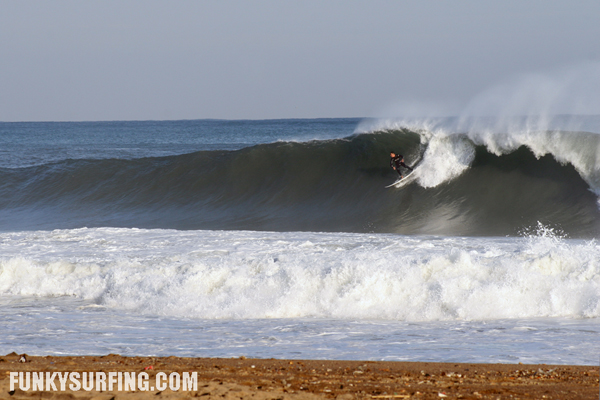In order to continue his pursuit of the ultimate free ride, Dora eventually turned to credit card and cheque fraud. Having been issued with, and subsequently broken, several probational services, Dora became a wanted man. Around 1975 he went on the run, spending much of his time in France, but also visiting South America and New Zealand. It was at this point that Dora began his affiliation with surf films and magazines, and as his mystique grew so did the appeal.
Dora’s downfall began with the onset of crowds and the explosion of the surfer image in mainstream media
Paid $10,000 by Surfer magazine for the in-depth article Million Days to Darkness, Dora was also featured in a Californian surf magazine cover titled Endless Summer. Both article titles appear to summarise Dora’s life in a particularly meaningful way; his obsession and fulfilment of seemingly endless surfing, followed by his eclipse as he was forced to run from authorities, and even spent three months in a French jail. Dora’s downfall began with the onset of crowds and the explosion of the surfer image in mainstream media. More surfers, with access to cheaper, better hardware meant that Dora’s original stomping grounds lost their unique appeal.
While few could keep up with “Da cat”, Dora became an ever more tortured individual as his nirvana, the blue waters of Malibu, were given over to music, movies and commercialism. As if in response to this, Dora launched his own line of “Da cat” surfboards, and featured himself being crucified against two surfboards in a photograph. It’s been said that this demonstrates Dora’s, and by extension surfing’s, demise at the onset of Malibu commercialism.
Once asked the question would he enter a contest for $1000 - $2000 prize money, Dora replied
“I ride for my pleasure only: no thanks. Professionalism will be completely destructive to any control an individual has over the sport at present. The organizers will call the shots, collect the profits, while the wave rider does all the labour and receives little. Also, since surfing’s alliance with the decadent big-business interests is designed only as a temporary damper to complete fiscal collapse, the completion of such a partnership will serve only to accelerate the art’s demise. A surfer should think carefully before selling his being to these people, since he’s signing his own death warrant as a personal entity.”
Despite his aversion to all things commercial, Dora capitalised on his mystique and fame by appearing in several surf films throughout the 1960’s. Including The Endless Summer (1966), Muscle Beach Party (1964), and Surf Party (1964), Dora demonstrated his progressive surf style for wider audiences.
Dora later returned to the USA, and died at his father’s home in California, aged 67 following a battle with pancreatic cancer.
With our waters becoming increasingly crowded, especially in Dora’s native clear waters of Malibu, it’s hard to imagine how he would have coped in a modern day line-up. Dora was undoubtedly an iconoclastic figure, railing against the inevitable advance of professionalism and industry which now permeates surf culture. By dedicating his life to the free ride, Dora became one of the greatest and well-known surfers of his generation. He chose to do this on his own terms, and in the process earned both the respect and condemnation of the wider surfing world. Nobody can dispute Dora’s talent in the water, and the impression he left on that golden Malibu shore.
Images: Our thanks to the team over at www.mikidora.com for all of the images used in this article. Head on over to the site to support their cause and help make a a permanent online history of the surfing legend.

































 Click here to sign up to our newsletter
Click here to sign up to our newsletter